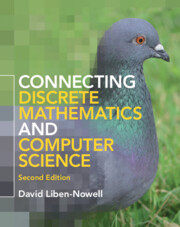Refine search
Actions for selected content:
48276 results in Computer Science
Variable ranking and selection with random forest for unbalanced data
-
- Journal:
- Environmental Data Science / Volume 1 / 2022
- Published online by Cambridge University Press:
- 20 December 2022, e30
-
- Article
-
- You have access
- Open access
- HTML
- Export citation
Week-ahead solar irradiance forecasting with deep sequence learning
- Part of
-
- Journal:
- Environmental Data Science / Volume 1 / 2022
- Published online by Cambridge University Press:
- 20 December 2022, e28
-
- Article
-
- You have access
- Open access
- HTML
- Export citation
An introduction to radical participatory design: decolonising participatory design processes
-
- Journal:
- Design Science / Volume 8 / 2022
- Published online by Cambridge University Press:
- 20 December 2022, e31
-
- Article
-
- You have access
- Open access
- HTML
- Export citation
A climatic random forest model of agricultural insurance loss for the Northwest United States
- Part of
-
- Journal:
- Environmental Data Science / Volume 1 / 2022
- Published online by Cambridge University Press:
- 20 December 2022, e29
-
- Article
-
- You have access
- Open access
- HTML
- Export citation
Parameter-efficient feature-based transfer for paraphrase identification
-
- Journal:
- Natural Language Engineering / Volume 29 / Issue 4 / July 2023
- Published online by Cambridge University Press:
- 19 December 2022, pp. 1066-1096
-
- Article
- Export citation
Emerging trends: Unfair, biased, addictive, dangerous, deadly, and insanely profitable
-
- Journal:
- Natural Language Engineering / Volume 29 / Issue 2 / March 2023
- Published online by Cambridge University Press:
- 19 December 2022, pp. 483-508
-
- Article
-
- You have access
- Open access
- HTML
- Export citation
Rethinking technologies of remembering for a postcolonial world
- Part of
-
- Journal:
- Memory, Mind & Media / Volume 1 / 2022
- Published online by Cambridge University Press:
- 19 December 2022, e17
-
- Article
-
- You have access
- Open access
- HTML
- Export citation

Connecting Discrete Mathematics and Computer Science
-
- Published online:
- 16 December 2022
- Print publication:
- 04 August 2022
-
- Textbook
- Export citation
A special issue on categorical algebras and computation in celebration of John Power’s 60th birthday, part II
-
- Journal:
- Mathematical Structures in Computer Science / Volume 32 / Issue 4 / April 2022
- Published online by Cambridge University Press:
- 16 December 2022, p. 348
-
- Article
-
- You have access
- HTML
- Export citation
References
-
- Book:
- Exponential Families in Theory and Practice
- Published online:
- 25 November 2022
- Print publication:
- 15 December 2022, pp 239-242
-
- Chapter
- Export citation
3 - Generalized Linear Models
-
- Book:
- Exponential Families in Theory and Practice
- Published online:
- 25 November 2022
- Print publication:
- 15 December 2022, pp 88-140
-
- Chapter
- Export citation
Frontmatter
-
- Book:
- Exponential Families in Theory and Practice
- Published online:
- 25 November 2022
- Print publication:
- 15 December 2022, pp i-iv
-
- Chapter
- Export citation
Introduction
-
- Book:
- Exponential Families in Theory and Practice
- Published online:
- 25 November 2022
- Print publication:
- 15 December 2022, pp xi-xii
-
- Chapter
- Export citation
Diversity, networks, and innovation: A text analytic approach to measuring expertise diversity
-
- Journal:
- Network Science / Volume 11 / Issue 1 / March 2023
- Published online by Cambridge University Press:
- 15 December 2022, pp. 36-64
-
- Article
- Export citation
Preface
-
- Book:
- Exponential Families in Theory and Practice
- Published online:
- 25 November 2022
- Print publication:
- 15 December 2022, pp vii-viii
-
- Chapter
- Export citation
4 - Curved Exponential Families, Empirical Bayes, Missing Data, and Stability of the MLE
-
- Book:
- Exponential Families in Theory and Practice
- Published online:
- 25 November 2022
- Print publication:
- 15 December 2022, pp 141-182
-
- Chapter
- Export citation
5 - Bootstrap Confidence Intervals
-
- Book:
- Exponential Families in Theory and Practice
- Published online:
- 25 November 2022
- Print publication:
- 15 December 2022, pp 183-238
-
- Chapter
- Export citation
Acknowledgments
-
- Book:
- Exponential Families in Theory and Practice
- Published online:
- 25 November 2022
- Print publication:
- 15 December 2022, pp ix-x
-
- Chapter
- Export citation
Multimodal mechanisms of political discourse dynamics and the case of Germany’s nuclear energy phase-out
-
- Journal:
- Network Science / Volume 11 / Issue 2 / June 2023
- Published online by Cambridge University Press:
- 15 December 2022, pp. 205-223
-
- Article
-
- You have access
- Open access
- HTML
- Export citation

